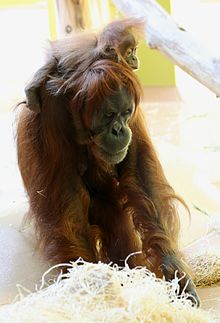Sumatran orangutan
| Sumatran orangutan | |
|---|---|
 |
|
| Male | |
 |
|
| Female with infant | |
| Scientific classification | |
| Kingdom: | Animalia |
| Phylum: | Chordata |
| Class: | Mammalia |
| Order: | Primates |
| Suborder: | Haplorhini |
| Family: | Hominidae |
| Genus: | Pongo |
| Species: | P. abelii |
| Binomial name | |
|
Pongo abelii Lesson, 1827 |
|
 |
|
| Distribution in Indonesia | |
| NCBI genome ID | 325 |
|---|---|
| Ploidy | diploid |
| Genome size | 3,441.24 Mb |
| Number of chromosomes | 24 pairs |
| Year of completion | 2011 |
The Sumatran orangutan (Pongo abelii) is one of the two species of orangutans. Found only on the island of Sumatra in Indonesia, it is rarer than the Bornean orangutan. Its common name is based on two separate local words, "orang" ("people" or "person") and "hutan" ("forest"), and translates as 'man of the forest'.
Male Sumatran orangutans grow to about 1.4 m (4.6 ft) tall and 90 kg (200 lb). Females are smaller, averaging 90 cm (3.0 ft) and 45 kg (99 lb). Compared to the Bornean species, Sumatran orangutans are thinner and have longer faces; their hair is longer with a paler red color.
Compared with the Bornean orangutan, the Sumatran orangutan tends to be more frugivorous and especially insectivorous. Preferred fruits include figs and jackfruits. It will also eat bird eggs and small vertebrates. Sumatran orangutans spend far less time feeding on the inner bark of trees.
Wild Sumatran orangutans in the Suaq Balimbing swamp have been observed using tools. An orangutan will break off a tree branch that is about a foot long, snap off the twigs and fray one end. With its teeth, the orangutan will use the stick to dig in tree holes for termites. They will also use the stick to poke a bee's nest wall, move it around and catch the honey. In addition, orangutans use tools to eat fruit. When the fruit of the Neesia tree ripens, its hard, ridged husk softens until it falls open. Inside are seeds that the orangutans enjoy eating, but they are surrounded by fiberglass-like hairs that are painful if eaten. Tools are created differently for different uses. Sticks are often made longer or shorter depending on whether they will be used for insects or fruits. If a particular tool proves useful, the orangutan will often save it. Over time they will collect entire "toolboxes". A Neesia-eating orangutan will select a five-inch stick, strip off its bark, and then carefully collect the hairs with it. Once the fruit is safe, the ape will eat the seeds using the stick or its fingers. Although similar swamps can be found in Borneo, wild Bornean orangutans have not been seen using these types of tools.
...
Wikipedia

